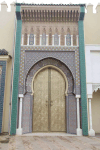
Large entrance door to the royal palace in Fez. (1053k)
From the Wikipedia entry for Fez:
Fez is the second largest city of Morocco after Casablanca, with a population of 1.1 million (2014). Located to the northeast of Atlas Mountains, Fez is situated at the crossroad of the important cities of all regions; 206 km (128 miles) from Tangier to the northwest, 246 km (153 miles) from Casablanca, 169 km (105 miles) from Rabat to the west, and 387 km (240 miles) from Marrakesh to the southwest which leads to the Trans-Saharan trade route. The old city is penetrated by the River of Fez flowing from the west to east.
Fez was founded on a bank of the Jawhar river by Idris I in 789, founder of the Idrisid dynasty. His son, Idris II (808), built a settlement on the opposing river bank. These settlements would soon develop into two walled and largely autonomous sites, often in conflict with one another: Madinat Fas and Al-'Aliya. In 808 Al-'Aliya replaced Walili (Volubilis) as the capital of the Idrisids. The migration of 2000 Arab families in the early 9th century gave the nascent city its Arabic character. After the downfall of the Idrisid dynasty, several empires came and went until the 11th century when the Almoravid Sultan Yusuf ibn Tashfin united the two settlements and rebuilt the city, which became today's Fes el Bali quarter. Under the Almoravid rule, the city gained the reputation for religious scholarship and mercantile activity. Fez was expanded during the Almohad rule and became the largest city in the world during 1170-1180 with an estimated population of 200,000.
Fez reached its zenith in the Marinid era, regaining the status as the capital. Numerous madrasas, mosques, zawiyas and city gates were constructed which survive until today. These buildings are considered the hallmarks of Moorish and Moroccan architectural styles. Marinid sultans also founded the Fes Jdid quarter, where newer palaces and gardens were established. During this time, the Jewish population of the city grew as well, with the Mellah (Jewish quarter) attracting the Jewish migrants from other North African regions. After the overthrow of the Marinid dynasty, the city largely declined and was replaced by Marrakesh for political and cultural influence. It remained the capital under the Wattasids and modern Morocco until 1912.
Today, the city largely consists of two old medina quarters, Fes el Bali and Fes Jdid, and the modern urban area of Ville Nouvelle constructed during the French colonial era. The medina of Fez is believed to be one of the world's largest urban pedestrian zones (car-free areas). It has the University of Al Quaraouiyine which was founded in 859. It is the oldest continuously functioning university in the world. It also has the Chouara Tannery from the 11th century, one of the oldest tanneries in the world.
Each local neighborhood in the medina had four important items: A school, a water fountain, a bakery, and a bath. I saw many of those, especially the many water fountains.
All pictures are © Dr. Günther Eichhorn, unless otherwise noted.

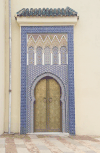
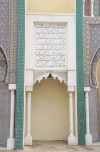
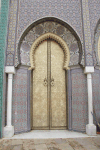



From the Wikipedia entry for Fes el Bali:
Fes el Bali is the oldest walled part of Fez. Fes el Bali was founded as the capital of the Idrisid dynasty between 789 and 808 CE. Besides being famous for having the oldest university in the world, the University of Al-Quaraouiyine, Fes el Bali, with a total population of 156,000, is also believed to be the biggest car-free urban area in the world.
From the Wikipedia entry for University of Al Quaraouiyine:
The University of Al-Quaraouiyine is a university located in the medina of Fez. It is the oldest existing, continually operating higher educational institution in the world according to UNESCO and Guinness World Records and is sometimes referred to as the oldest university. It was founded by Fatima al-Fihri in 859 with an associated madrasa, which subsequently became one of the leading spiritual and educational centers of the historic Muslim world. It was incorporated into Morocco's modern state university system in 1963.
The Medina of Fez is a UNESCO World Heritage Site.



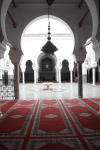
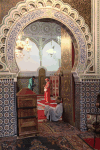
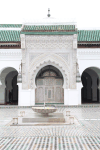
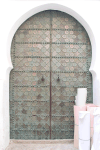
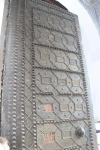


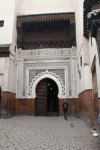
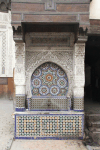
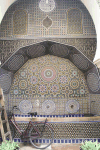
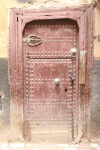

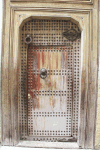
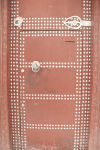

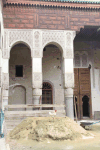
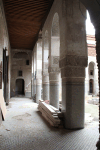

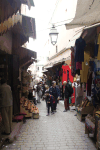
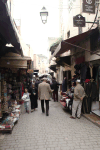

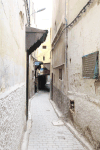
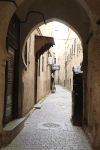
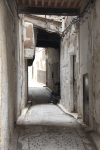
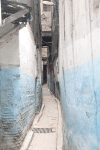
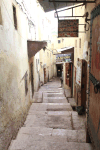
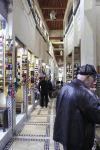

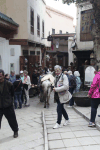

From the Wikipedia entry for Chouara Tannery:
Chouara Tannery is one of the three tanneries in the city of Fez, Morocco. Built in the 11th century, it is the largest tannery in the city. It is located in the Fes el Bali, the oldest medina quarter of the city, near the Saffarin Madrasa along the river. Since the inception of the city, tanning industry has been continually operating in the same fashion as it did in the early centuries. Today, the tanning industry in the city is considered one of the main tourist attractions. The tanneries are packed with the round stone vessels filled with dye or white liquids for softening the hides. The leather goods produced in the tanneries are exported around the world.
The most notable feature of the tannery is the numerous stone vessels filled with the different colors of dyes or white liquids. Hides of cows, sheep, goats and camels are processed here by soaking into the vessels. At first, they are soaked into the white liquids made of cow urine, pigeon feces, quicklime, salt and water, in order to break down the tough leather. This process takes two to three days, making the leather malleable for absorbing the dye. The hides are then soaked into the dyeing water made of natural vegetables such as poppy for red, indigo for blue and henna for orange. After the dyeing, they are dried under the sun. The hides produce the high quality leather goods such as bags, coats, shoes and slippers. The production process consists of manual labor and involves no modern machinery, and has been retained its method since the medieval era.










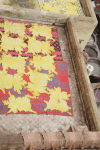
From the Wikipedia entry for Mellah:
A mellah is a walled Jewish quarter of a city in Morocco, analogous to the European ghetto. The first official mellah was established in the city of Fez in 1438. Jewish population were confined to mellahs in Morocco beginning from the 15th century and especially since the early 19th century. It first was seen as family Benyamina living privilege and a protection against the Arabs' attacks in the region, but with the growing of the population, it then became a poor and miserable place. With the colonization and the arrival of the Europeans at the end of the 19th century and the beginning of the 20th century, the Mellah opened and gave new economical and social possibilities to the Moroccan Jews. These spaces allowed Jewish individuals to develop the identity of the "Moroccan rabbinate, the sociology of the mellah synagogue, lay community leadership, and the historic role of the Sephardic heritage in Morocco."
In cities, a mellah was surrounded by a wall with a fortified gateway. Usually, the Jewish quarter was situated near the royal palace or the residence of the governor, in order to protect its inhabitants from recurring riots since its inhabitants played a vital role in the local economy. In contrast, rural mellahs were separate villages inhabited solely by the Jews. Not all cities in Morocco had mellahs. In many of these cities, there were primarily Jewish neighborhoods, but they didn't come with the safety benefits and protections as a mellah.

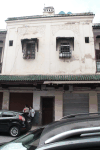
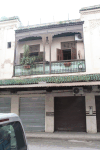
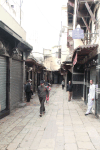
This page contains 55 pictures

Main page for المغرب (Morocco)
Page last updated on Sun Jun 5 14:15:46 2022 (Mountain Standard Time)
Page last updated on Thu Apr 25 10:52:35 2024 (Mountain Standard Time)